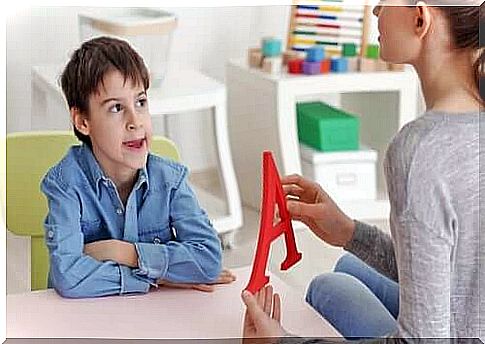Severe Speech And Language Difficulties In Children

In this article, we are talking about severe speech and language difficulties in children. People of all ages and backgrounds can have language problems. From very complex issues that make communication impossible, to simple things like confusing the letter ‘r’ with the letter ‘l’.
Most of these problems are especially common during childhood, when language development and learning are at their peak. One type of language disorder in children is called severe speech and language difficulties, or ESM.
Children’s brains develop by leaps and bounds. Their most complex cognitive functions develop incredibly quickly. Language is one of the most important, given the role it has played in our evolution as a species.
The ability to communicate in different ways has broadened the range of coordinated activities within the reach of humans.
However, language is also an extremely complex skill that children develop and refine when they are still young. Most language disorders begin during childhood. If left untreated, they can cause problems later in life.

What does severe speech and language difficulties mean?
Severe speech and language difficulties is a disorder that occurs in children who have learning disabilities or disabilities. Since cognitive abilities vary from person to person, experts talk about EMS in cases where there is a specific disability.
While the disability can also compromise other skills, it is generally a selective deficit for particular learning, not a global deficit. The most famous example is dyslexia. People with dyslexia have difficulty learning to read and write, despite having a normal level of intelligence.
Brain maturation and language development
Language development is gradual and depends on proper neural development in the brain. Spontaneous language begins at the age of two. It coincides with significant motor development. This process coincides with an increase in the degree of myelination in the neurons of the nervous system.
For example, at six months of age, it is possible for a baby to smile, thanks to a baby’s motor development and ability to communicate with others.
Another example is a five-year-old who has nearly completed motor development and can perform more complex verbal tasks than saying their age or repeating four numbers.
What happens in case of early brain damage?
Early brain damage is often the result of an accident. The first potential blemish is caused by the injury itself, due to nearby neural changes from nervous system damage. Learning abnormalities happen later. They are the result of reorganization within the nervous system.
Neuroplasticity in children allows for functional restructuring, but that does not eliminate the possibility of a developmental disorder. The type of injury will determine whether the impairment will be diffuse or focused.
Dyslexia
Dyslexia is a learning disability in which a person has difficulty reading due to problems with the order of words, syllables, and letters. This is the most common disorder when we talk about severe speech and language difficulties.
It can be the result of a basic problem with auditory processing and a visual perceptual impairment. It is interesting to note that the limitation depends on the writing system in question.
How do you identify dyslexia?
Children with dyslexia have problems correctly perceiving elements of written language. Four possible manifestations of dyslexia are:
- Problems paying attention. Certain tasks require too much cognitive resources, leading to mental fatigue and problems paying attention or concentrating.
- Lateralization problems. Finding it difficult to distinguish left and right and general spatial problems.
- Difficulty recognizing and naming different fingers.
- Feelings of insecurity and stubbornness.
What is the difference between dyslexia and dyscalculia?
People with dyslexia have no particular problems with numbers. Their limitation means that they generally have difficulty understanding abstract concepts related to language. Dyscalculia, on the other hand, is the inability to mentally solve problems. To diagnose dyscalculia, therapists look for:
- Difficulty learning and remembering basic operations.
- Difficulty identifying and using characters correctly.
- The inability to calculate head. Using more rudimentary strategies, such as counting with your fingers.
- Difficulty understanding numerical concepts such as ‘greater than’.
- Problems with the abstract and spatial representation of numbers, leading to problems with writing numbers.
Differences between severe speech and language difficulties and intellectual disabilities
Severe speech and language difficulties, as we mentioned above, are developmental problems that only occur with language. However, they can also affect other areas of the brain.
Intellectual disabilities, on the other hand, are a complete alteration of intellectual functioning. It manifests in the early stages of development as intellectual abilities that are below average.
Severe Speech and Language Difficulties: Evaluation and Treatment
Usually, a multidisciplinary team works together to diagnose severe speech and language difficulties. The team often consists of:
- Speech therapist. Responsible for identifying which language area is causing the restriction.
- Neuropsychologist. In the case of brain injury, the neuropsychologist evaluates executive function. He can also make a differential diagnosis to rule out other problems.
- Psychologist. Responsible for dealing with the emotional side of having speech and language difficulties. Many children with learning disabilities also have problems at home.
- Teacher. Teachers are a crucial part of the team because they usually identify the problem at school.
Other specialists such as neurologists, doctors and psychiatrists may also be involved, in case of brain injury or other physical cause.

Therapy
More than one specialist is also involved in the treatment. After identifying the disorder, the team develops a strategy to correct it. The speech therapist is usually the one who gives the patient exercises to improve his language skills.
For example, if a child has a phonetic disability that causes them to mispronounce words (for example, by replacing the ‘l’ with the ‘r’), the speech therapist will develop a series of motor and linguistic articulation exercises to correct the movement of the mouth.
The intervention changes depending on the type of disability the child has. In this phase, teacher involvement in language and listening is crucial. They should pay special attention to language comprehension and expression problems.
Finally, it is important to point out that children have a high degree of brain plasticity because they still form important connections. That is why it is so important to treat severe speech and language difficulties as soon as possible.
For example, treating your child’s dyslexia as early as possible can help them develop strategies and skills to compensate for their disability. With treatment you can prevent problems later in life. It is much more difficult to correct problems when you are in your twenties or thirties.









